The ASUS Zenfone 8 Hands-On Review: A New Compact Direction
by Andrei Frumusanu on May 12, 2021 1:30 PM EST- Posted in
- Smartphones
- Asus
- Mobile
- Zenfone 8

Today ASUS is launching their new mainstream line-up of flagship devices, the Zenfone 8 series. Unlike last year’s iteration of the Zenfone 7 which was defined by the flip-camera design, ASUS is mixing up the formula this year with the new Zenfone 8, a completely different phone in a completely different form-factor, targeting a niche in the market which ASUS sees as an opportunity to differentiate itself in.
The Zenfone 8 is defined by its size: with a 5.9” screen and a width and height of 68.5 and 148mm, it’s by far one of the smallest flagship SoC powered devices in the market. It’s an extreme departure from the Zenfone 7 – however ASUS also introduces the Zenfone 8 Flip, essentially a Snapdragon 888 upgrade over what we’ve seen in the Zenfone 7, though this variant of the Zenfone 8 will be limited in terms of market availability, and today’s article will focus on the smaller Zenfone 8.
| ASUS ZenFone 8 Series | |||||
| ZenFone 8 Flip |
ZenFone 8 |
||||
| SoC | Qualcomm Snapdragon 888 1x Cortex-X1 @ 2.84GHz 3x Cortex-A78 @ 2.42GHz 4x Cortex-A55 @ 1.80GHz Adreno 660 @ 840MHz |
||||
| DRAM | 6 GB LPDDR5 | 6/8/16 GB LPDDR5 | |||
| Storage | 128GB UFS 3.1 + microSD |
128/256GB UFS 3.1 | |||
| Display | 6.67" AMOLED 2400 x 1080 (20:9) 90Hz 200Hz Touch |
5.9" AMOLED 2400 x 1080 (20:9) 120Hz 240Hz Touch |
|||
| Size | Height | 165.08 mm | 148.0 mm | ||
| Width | 77.28 mm | 68.5 mm | |||
| Depth | 9.6 mm | 8.9 mm | |||
| Weight | 230 grams | 169 grams | |||
| Battery Capacity | 5000mAh 30W charging (PD3.0) |
4000mAh 30W charging (PD3.0) |
|||
| Wireless Charging | - | ||||
| Rear Cameras | |||||
| Main | 64MP IMX686 0.8µm pixels (1.6µm 4:1 16MP) f/1.7 |
64MP IMX686 0.8µm pixels (1.6µm 4:1 16MP) f/1.7 w/OIS |
|||
| Telephoto | 8MP 3x optical zoom f/2.4 |
n/a | |||
| Wide | 12MP IMX363 1.4µm pixels Dual PDAF 113° FoV ultra-wide f/2.2 |
||||
| Extra | - | ||||
| Front Camera | Flip-camera Design Front cameras = Rear cameras |
12MP IMX663 1.22µm |
|||
| I/O | USB-C | USB-C 3.5mm headphone |
|||
| Wireless (local) | 802.11ax WiFi-6 Bluetooth 5.1 LE + NFC |
||||
| Other Features | Triple-function Power Button w/ Capacitive Fingerprint Sensor | IP68 Dual Speakers Under-screen fingerprint sensor |
|||
| Dual-SIM | Dual nanoSIM | ||||
| Launch Price | 21,999 TWD (USD~748, EUR~626) |
starting 599€ | |||
The Zenfone 8 and 8 Flip are powered by the new Snapdragon 888. We’ve reviewed the SoC quite extensively over the last few months in a wide range of devices from various vendors – the chip is characterised by increased performance coming at a cost of quite higher power usage due to the shift to a regressed 5nm process node.
ASUS equips the Zenfone 8 from 6 to 16GB of LPDDR5 RAM depending on the SKU model you chose, and comes equipped with 128 or 256GB of UFS 3.1 storage, with no microSD option this time around.
As noted, what really differentiates the Zenfone 8 from its predecessors as well as from other smartphones in the market is its more diminutive stature. At 148 x 68.5 x 8.9mm and only 169g weight, the Zenfone 8 is one of the smallest phones in the market, especially amongst devices powered by the latest flagship hardware internals.
ASUS states that this was a deliberate market positioning that they are experimenting with: the company has seen that while there’s tons of competitors in the now regular “larger” form-factor of phones, there’s actually very little options when it comes to smaller devices. Sony’s Xperia 5 series was one of the rare ones out there with a phone width below 70mm, however many people didn’t like Sony’s extremely elongated aspect ratio, and ASUS pointing out that the Zenfone 8 is now also the only option out there with a device height of below 150mm.
ASUS’s strategy here is I think excellent, and allows them to fill a niche in the market and compete for customers who are looking for such devices. The ergonomics of the Zenfone 8 are generally excellent due to its smaller size, but ASUS also designed the phone to have good in-hand feel due to the curved back glass design as well as the rounded metal frame of the phone.
The build quality of the phone is excellent, and I particularly notice the removal of the plastic “gasket” piece between the phone frame and the display glass that’s usually found on cheaper devices in the market.
The screen itself is a 5.9” OLED with 2400 x 1080 resolution, with an upgraded refresh rate of up to 120Hz, and a touch input of up to 240Hz. Unfortunately there is no variable refresh rate here, neither software nor hardware, so anything above 60Hz comes at the cost of battery life.
The Zenfone 8 uses a “regular” hole-punch front camera module instead of a mechanical flip mechanism of the rear cameras, which is completely fine due to the design limitations of such a much smaller device. I found it a bit weird that ASUS adopted this metallic ring design around the camera – I’ve seen it used before on other devices and I was not fan of it as it really draws the attention to the camera instead of making it inconspicuous. At least here on the Zenfone 8 it’s centred perfectly within the display hole.
The camera setup on the Zenfone 8 is extremely simple: it features the same main camera and ultra-wide module as found on last year’s Zenfone 7 Pro series, meaning a 64MP IMX686 main camera module that bins down to 16MP 1.6µm in regular auto mode pictures and features a f/1.7 optics with OIS, and a 113° UWA module powered by a 12MP IMX363 and f/2.2 aperture with autofocus capabilities. Generally we were not very impressed with this camera setup on the Zenfone 7 last year, and have similar low expectations of the Zenfone 8 – we’ll quickly check out some samples later in the piece.
The bottom of the phone features your typical SIM tray, which this time around does not feature a microSD anymore, USB-C port, as well as a good quality main speaker. Between the USB port and the speaker hole there’s actually also a small LED notification light – something that over the years has seen been deprecated by various vendors in favour on always-on displays. I greatly appreciate this feature as it’s much more power efficient compared to AOD notifications.
At the top of the phone, we find the mythical and elusive 3.5mm headphone jack. Over the many years we see countless vendors drop the feature and trying to promote wireless headphones which cost, more, have worse audio quality, and are prone to degradation due to batteries. Sony and ASUS are two vendors who did drop the headphone jack in the past and reintroduced them in subsequent generations due to negative feedback, so I applaud ASUS for also including it here on the Zenfone 8.
What’s new for ASUS, is the Zenfone 8 is an IP68 rated device, which was one feature limitation of the mechanical flip-camera design of the Zenfone 7, and continues to be so for the Zenfone 8 Flip.
Today’s hand-on review focuses around the Zenfone 8 as that’s what ASUS had sent out as samples, but the company is also launching the Zenfone 8 Flip. This phone is essentially identical to the Zenfone 7 with the exception for the upgrade to a new Snapdragon 888 SoC. Unfortunately, the 8 Flip will see a much more limited release compared to the Zenfone 8, notably with it not launching in the North American market.


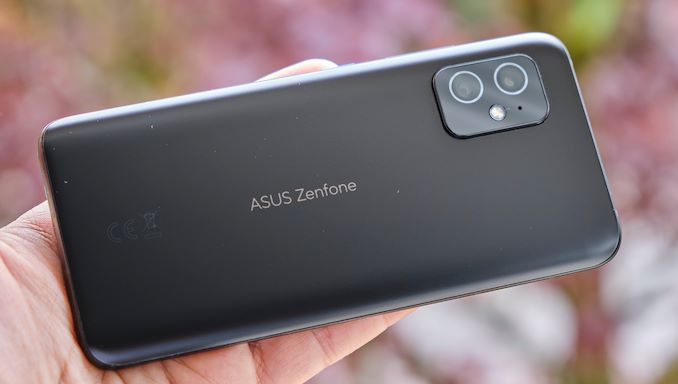
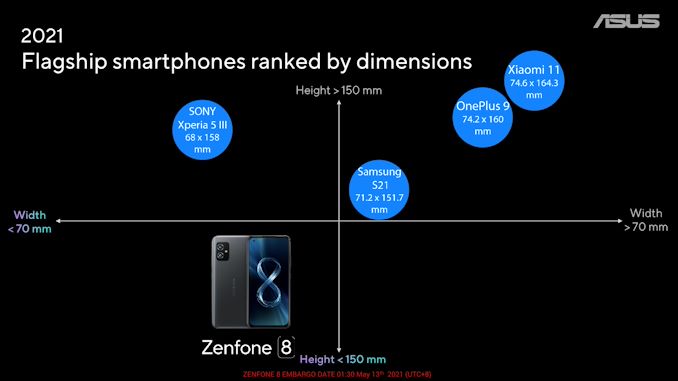
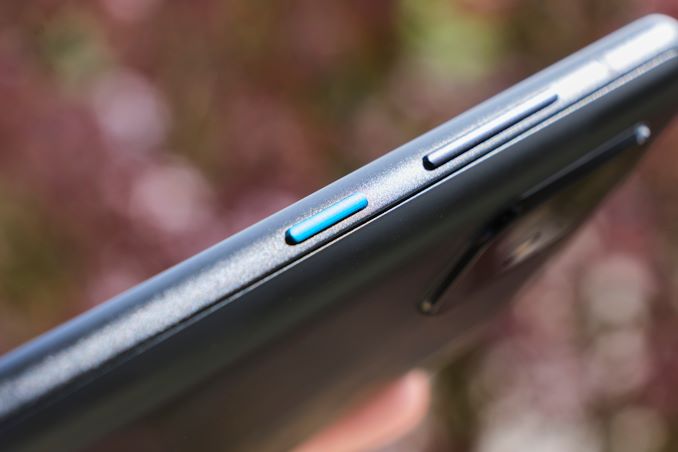
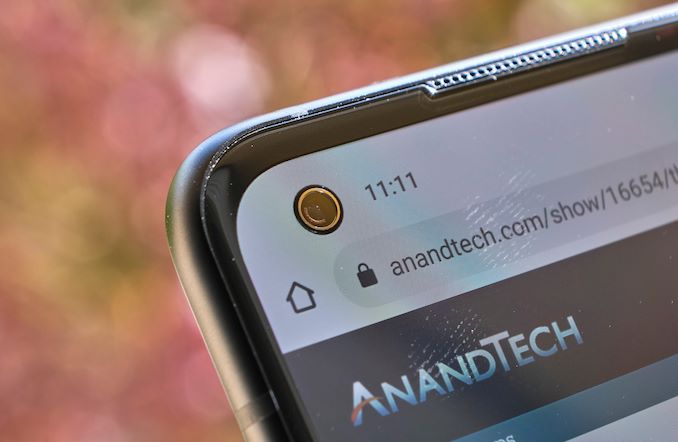


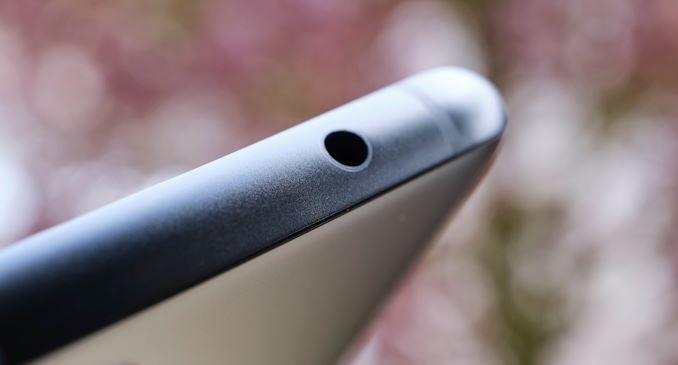








66 Comments
View All Comments
drajitshnew - Thursday, May 13, 2021 - link
I do not understand -- they should be adding micro SD express.thejaredhuang - Wednesday, May 12, 2021 - link
So I've seen the picture of the 4000mAh battery on 2 different sites, it looks like its easily replaceable once the back cover is off, Andrei do you have any info on how easy it is to remove the back cover?Unashamed_unoriginal_username_x86 - Wednesday, May 12, 2021 - link
The paragraph on the last page starting with "As we always say" is duplicatedWereweeb - Wednesday, May 12, 2021 - link
I actually quite like this one. Not gaudy, not cringy, not exaggerated, just an all-around solid and compact smartphone. The camera bump does look misaligned, and the chrome ring around the selfie cam is just one of the dumbest things I've ever seen; but otherwise, if I needed to daily carry a SD 888, this would be the phone I'd buy.Silver5urfer - Wednesday, May 12, 2021 - link
No 3.5mm jack on the Flip and no SD slot on the both phones, bonus is get a hole in cheaper version. Well this is going to be a skip. Sony Xperia 1 Mark III is still the king on the smartphones right now, king in price also unfortunately.SD slot is not about storage, it's about having things right near your fingertips in the case of any emergency - Phone cracked / Phone busted up need to send to factory / Immediately need to get data to a PC / any private data. That is not possible with any solution, Cloud is not a solution at all as it needs constant Internet access and background data usage PLUS it's going to a blackbox security system putting all your data behind a ToS and Privacy Corporate Policy.
flyingpants265 - Wednesday, May 12, 2021 - link
You'll never get what you need by relying on a private corporation - if you want actual utility, you'll need a government subsidy or non-profit or something. The population is never going to "learn to make the right choices", that day is never coming.What's needed is several different models of fully-featured Linux phones. Won't happen.
ozon - Friday, May 14, 2021 - link
There's microSD slot on the 8 Flip. Saw it listed on the Asus page.nicolaim - Thursday, May 13, 2021 - link
No wireless charging: lame.JfromImaginstuff - Thursday, May 13, 2021 - link
You do realise that wireless charging is still very inefficientads295 - Thursday, May 13, 2021 - link
I think there should be a law forcing it to be named "wired wireless charging" until we can transmit at least 5W of power over a distance of 1 metre.